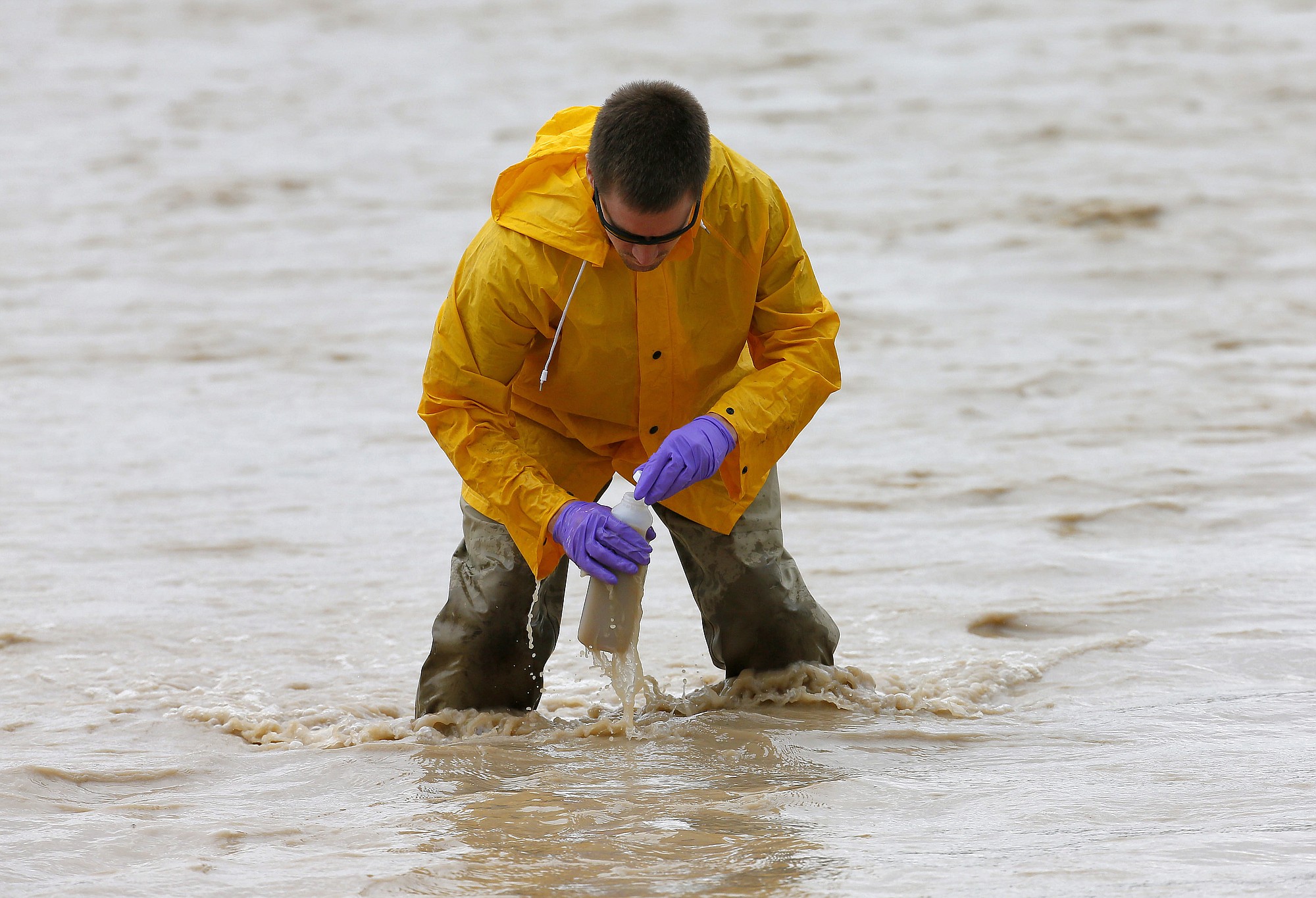DENVER — The U.S. Environmental Protection Agency took full responsibility Tuesday for the mine waste spoiling rivers downstream from Silverton, Colo., but people who live near the idled and leaking Gold King mine say local authorities and mining companies spent decades spurning federal cleanup help.
They feared the stigma of a Superfund label, which delivers federal money up-front for extensive cleanups. They worried that corporations would kill a hoped-for revival in the area’s mining industry lest they get stuck with cleanup costs. And some distrusted the federal government, townspeople say.
The EPA pushed anyway, for nearly 25 years, to apply its Superfund program to the Gold King mine, which has been leaching a smaller stream of arsenic, lead and other wildlife-killing heavy metals into Cement Creek. That water runs into the Animas and San Juan rivers before reaching Lake Powell and the lower Colorado River, a basin serving five states, Mexico and several sovereign Native American nations.
As millions of gallons of spilled sludge spread hundreds of miles downstream Tuesday, officials from the century-old mining towns of southwest Colorado defended their opposition to federal help.
Mining companies don’t like to invest in Superfund sites because they’re heavily scrutinized and more costly to develop, said Ernest Kuhlman, a San Juan County commissioner and Silverton’s former mayor.
Also, the stigma could have scared away rafters and anglers who helped bring $19 billion in tourism money to Colorado last year.
“How many people want to go to a Superfund site for tourism or recreation?” Kuhlman asked.
Now they’ve got a bigger problem: Last Wednesday, a small EPA-supervised work crew inspecting the Gold King mine accidentally knocked a hole in a waste pit, releasing at least 3 million gallons of acidic liquid laden with toxic heavy metals. Dissolved iron in the waste plume — familiar to miners as “yellow boy” — turned the area’s scenic waterways a shocking orange hue.
The EPA ordered stretches of the rivers closed for drinking water, recreation and other uses at least through Monday. Colorado and New Mexico made disaster declarations. The Navajo Nation declared an emergency, saying that at least 16,000 of its people, 30,000 acres of crops and thousands of livestock survive on water that’s now off-limits.
In Washington, EPA administrator Gina McCarthy took full responsibility, saying “I am absolutely, deeply sorry that this ever happened.” She planned to tour Farmington and Durango, two of the cities most affected by the orange sludge.
Since 1980, Superfund designation has helped remove or contain hazardous waste posing immediate dangers to human health. New York’s Love Canal, where hundreds of families had to be evacuated from homes built over a former chemical dump, spurred its creation, and many still associate that scandal with the program.
Asked if Superfund designation could have helped to prevent this accident, regional EPA administrator Shaun McGrath indicated it could have.
“Being listed under a national-priorities list … makes available to a clean-up effort resources under the Superfund, which are significant resources,” McGrath said. “And it does allow for potentially more extensive clean-up.”
Fears that a Superfund site nearby will sink property values and chase away investment are common in America; numerous studies have explored this topic. But “normally, people want it to be cleaned, so if that’s the best way of moving through it, generally communities want” Superfund designation, said Katherine Kiel, who teaches at the College of the Holy Cross in Worcester, Mass.
As many as 500,000 mines have been abandoned in the U.S., legacies of the booms and busts that follow swings in metals prices, according to the U.S. Bureau of Land Management. Many date to the late 1800s, and have been exposed to the elements for many years, their tunnels filling with snowmelt and rain that leaches underground.
Bill Simon, a coordinator for the Animas River Stakeholders Group, said clean-up negotiations have focused on 33 of the most contaminated mines and 34 mine waste sites, out of an estimated 3,000 in the Animas river basin, but work has been stalled by questions about who will ultimately pay for it.
The biggest Superfund proponents, he said Tuesday, are from downstream communities who fear pollution from mines will harm their economy, and want federal help to clean it up as quickly and effectively as possible.
On the other side are people in Silverton who fear reduced property values and a loss of local control to a federal bureaucracy, Simon said, and they’re backed by some of the world’s biggest mining interests.
In 2011, Canada’s Kinross Corporation, which owns the area’s Sunnyside mine, offered $6.5 million to help clean mining waste from the upper Animas River, while vowing to “vigorously contest” any effort to make Sunnyside liable for Superfund-related clean-up costs.
Sunnyside has yet to spend the money, but continues to support a “collaborative approach” among various parties, Sunnyside reclamation director Kevin Roach said in an email Tuesday.
Mark Esper, editor of the Silverton Standard & the Miner’s newspaper, hopes the spill will soften suspicions about federal involvement.
“One of the biggest concerns you hear about Superfund is, “Oh, the bad publicity we get,” Esper said. “Well, it can’t get much worse than this right now, frankly.”



